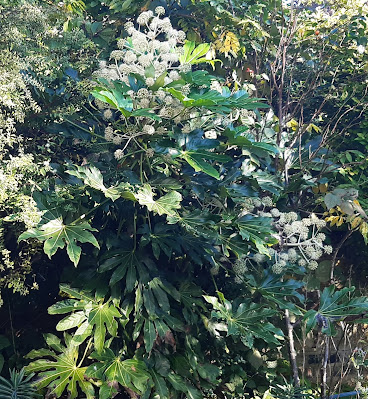A neighbour took this bird's eye view of my garden last winter. It shows rather well the ribbon-like narrowness and length. It also shows how verdant it is all year round, due to the yew hedge and other evergreen shrubs, the always-for-some-reason lush grass, the feathery tree fern and the golden privets.
From above, you can see clearly the usefulness of different plant shapes and spaces in dividing and concealing the ribbon-like shape of the place. (You can also see the fox sunbathing on the shed roof.)
The stalwarts this year are the Fatsia japonica, a self sown plant with enormous hand-shaped leaves and clusters of white flowers, a bit like the flowers on the masses of mature ivy at the back of the garden. Both the ivy and the fatsia attract insects and on a sunny day last week were swarming with bees.
Fatsia japonica and ivy both attract swarms of bees and other insects
While I am raking up the autumn leaves I can admire the large rounded bush of Viburnum farreri at the front of the house which is full of flower just now. Theoretically, the leaves should have dropped and the flowers be purely on their own but not this year. The other Viburnum - Bodnantense - by the yew hedge is in the same state: lots of flowers which should be on their own are still sharing the branches with leaves.
 |
| Viburnum farreri |
The tree fern is in full leaf and wonderfully green and lacy and the four rounded bulkheads of golden privet truly glow in the sun.
 |
| Seed heads of asters left for the birds and because they are pretty |




.jpg)
Comments
Post a Comment